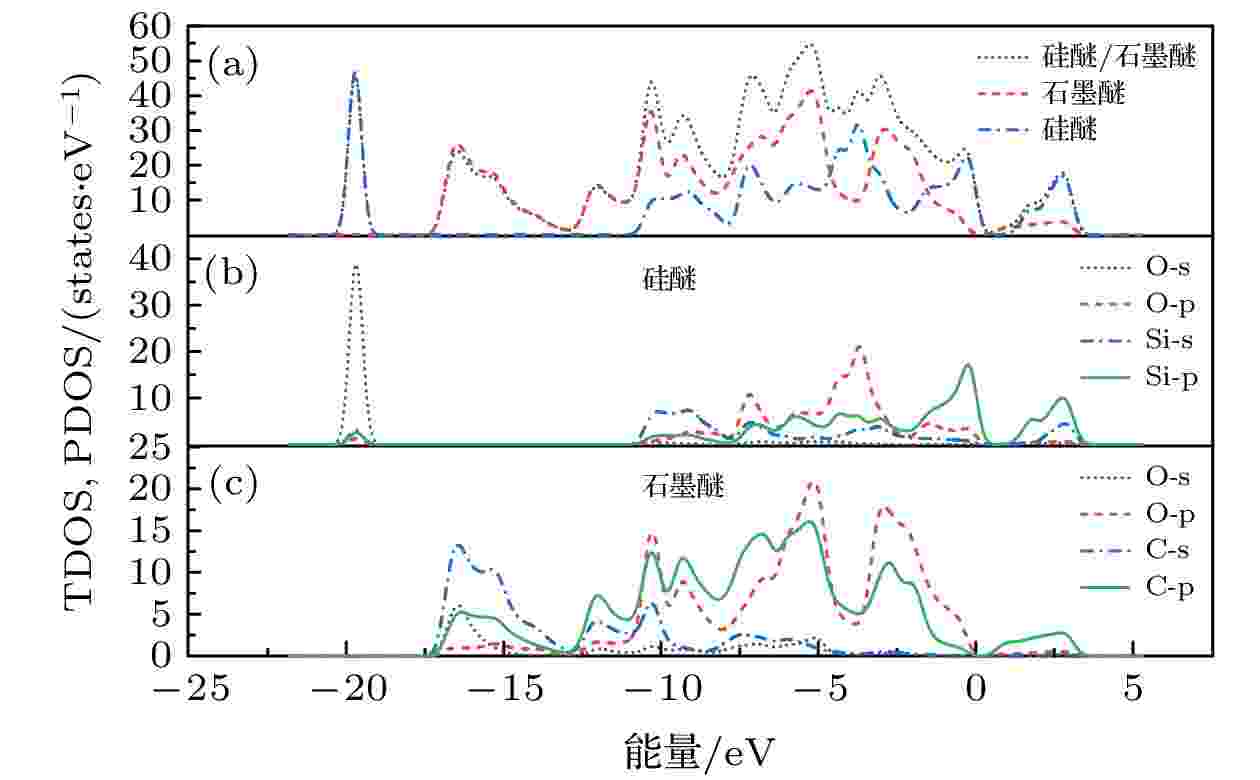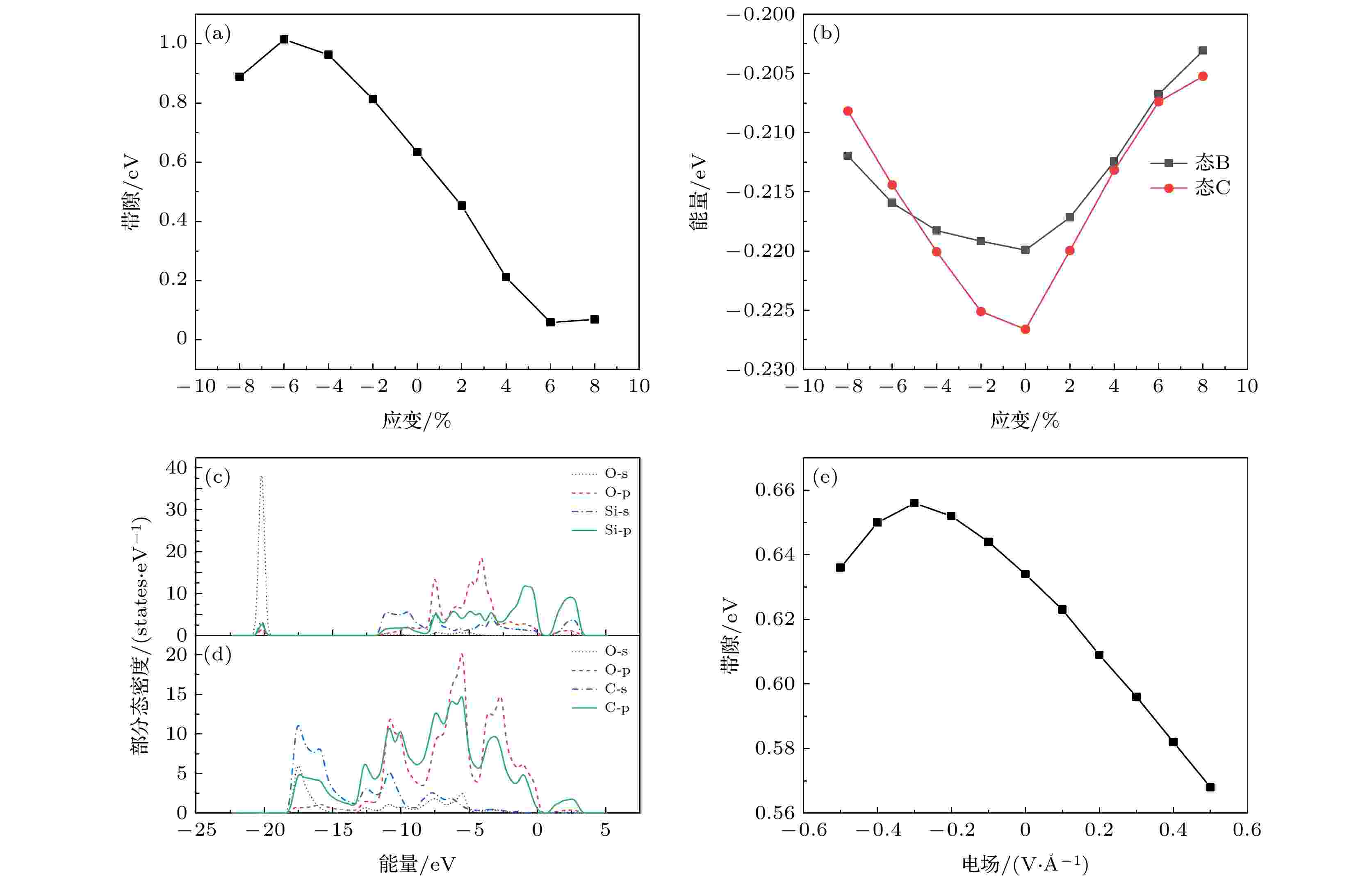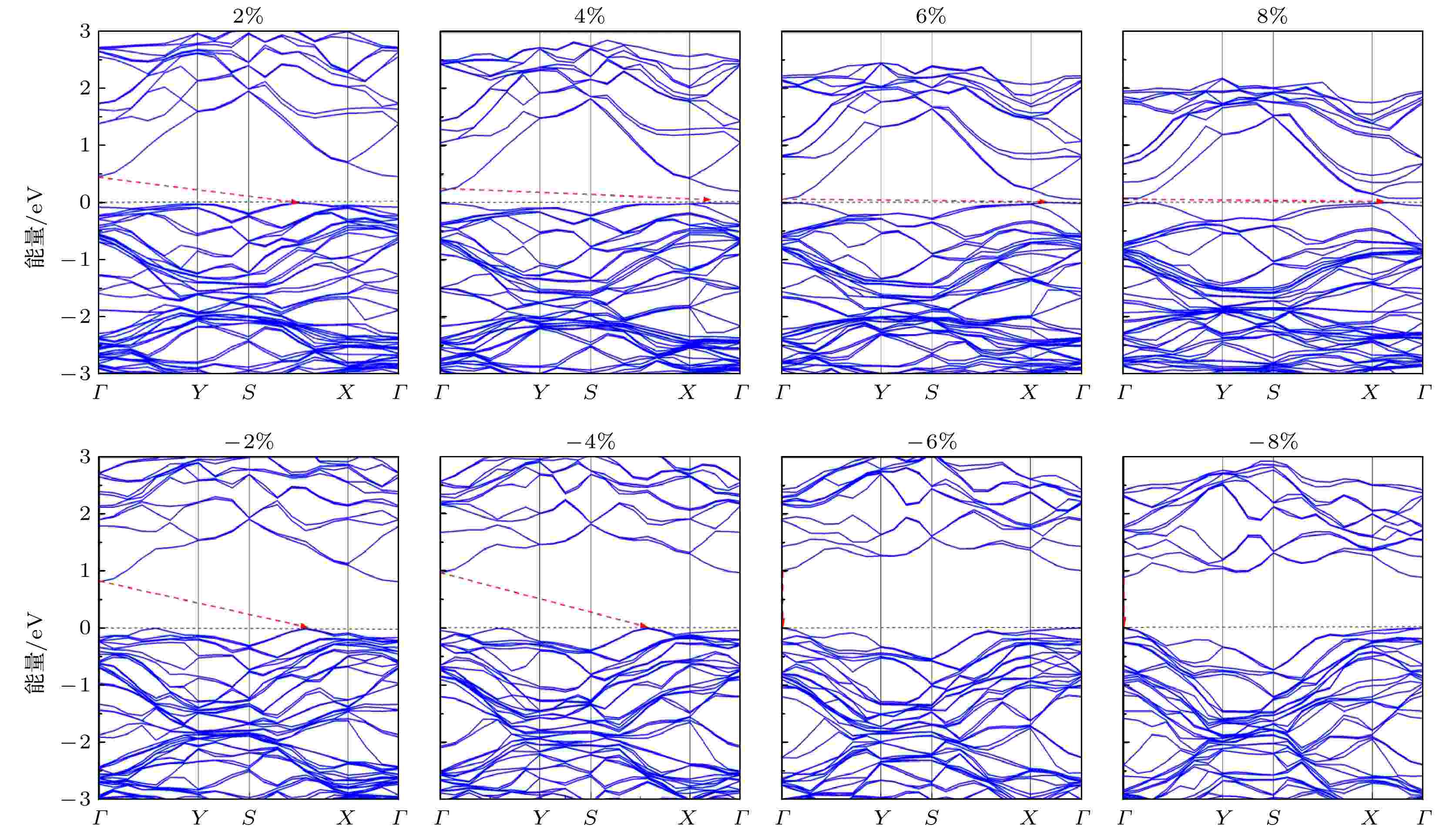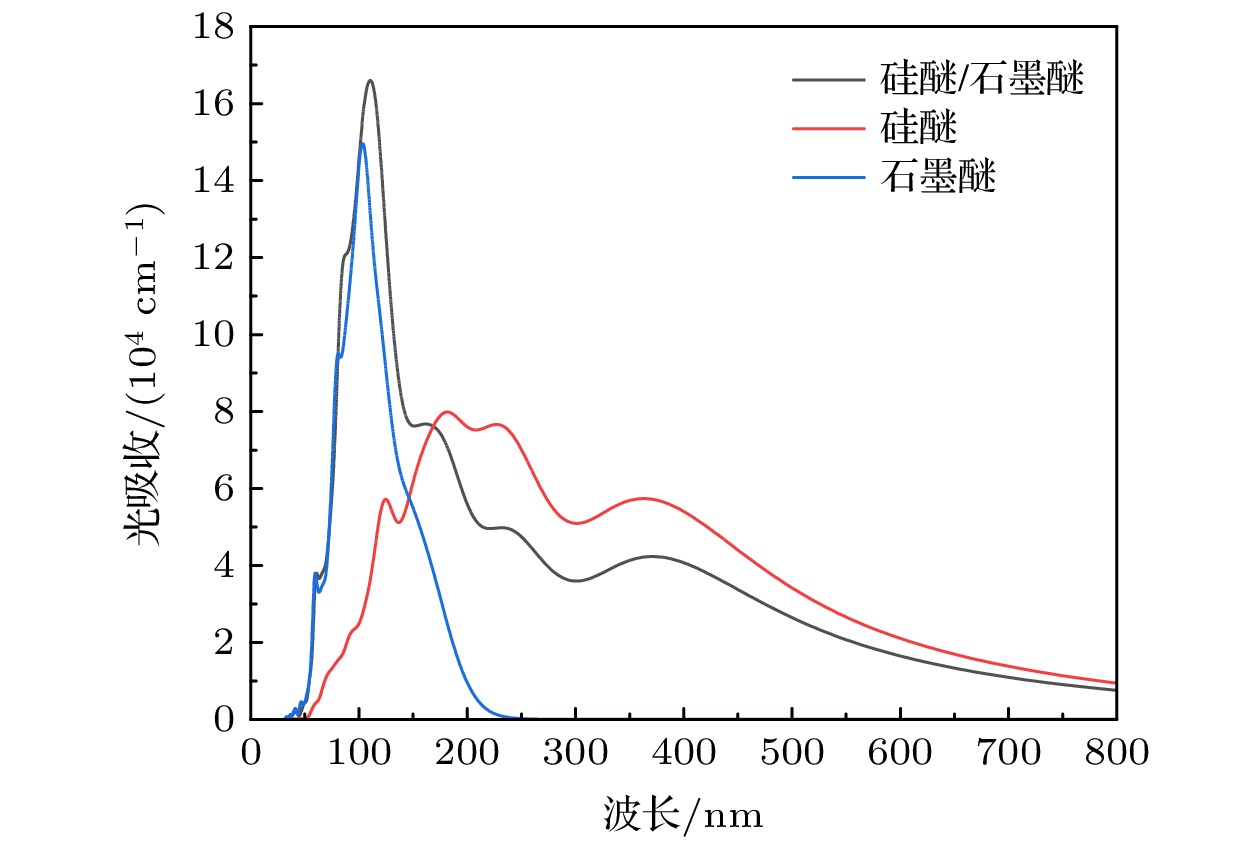全文HTML
--> --> -->在对单一的二维材料进行深入研究的同时, 另一个研究领域也同时出现, 即由不同二维材料耦合而形成的异质结构. 迄今为止, 已有许多实验和理论方法来研究二维异质结构的优点, 如石墨烯/氮化硼[23-25]、砷烯/锑烯[26]、砷烯/石墨烯[27]. 这些研究表明, 异质结构具有优异的光学和电子性能, 被认为是极有前景的新型微电子器件. 例如, Chen等[28]研究了硅锗(SiGe)和氮化硼(BN)结合形成的异质结构, 结果表明异质结构的带隙相对于单层SiGe扩大到约57 meV. 此外, 与两个单分子层相比, 异质结构的光学性质得到提高, 并主要增强其在紫外光区的光学性质. 因此, 更有利于异质结构在微电子和光电子领域的应用.
如今, 异质结构如石墨烯/过渡金属硫族化合物[29-31]、锑烯/锗烯[32]、硫化镓/硒化镓[33]、石墨烯/砷化镓[34]、氮化硼/硅烯[35]、硅锗/氮化硼[28]以及磷烯/氮化硼[31]等已受到广泛关注. 它们结合形成的异质结构与单个的二维材料相比具有优异的性能. 通过改变层间距、施加外加电场和应变, 可以有效地调节带隙. Wang等[36]研究了锑烯/砷化镓异质结构的电子结构和光学性质, 发现在不同的界面相互作用下会发生直接带隙和间接带隙的改变, 使异质结构更适合纳米器件的应用. 此外, 异质结构的形成可以产生较高的光吸收系数, 因此锑烯/砷化镓异质结构在光电器件应用中可作为潜在的新材料. Cao等[37]通过对锡/氧化锌异质结构施加外加电场和应变, 结果表明电场可以调控电导率, 提高电子传输性能. 此外, 当对异质结构施加压缩应变时, 会发生由间接带隙向直接带隙的转变, 当施加拉伸应变时, 带隙会急剧减小. 这种电子性质可调的异质结构将在纳米领域得到应用.
最近, 二维石墨醚[38]和硅醚[39]被理论预测为具有优异的电子和光学性能的新型半导体材料. 石墨醚具有各向异性的光学特性, 并且在紫外区表现出强吸收. 硅醚的吸收范围从紫外区到可见区. 由于其优异的特性, 使其在纳米电子和光电子领域具有广阔的应用前景. 因为异质结构合成单个材料的属性, 表现出独特的光学和电子性能. 此外, 异质结构的电子性质对应变和电场都很敏感, 可以满足实际应用. 所以将石墨醚和硅醚结合为具有期望的电子和光学性质的异质结构是可行的.
基于密度泛函理论的第一性原理计算方法被广泛应用于新型功能材料的预测及性能研究[28,40-42]. 本文设计了一种新型的由硅醚和石墨醚组成的二维硅醚/石墨醚异质结构. 通过第一性原理计算, 从理论的角度系统地研究了其几何结构、电子性质和光学性质. 结果表明, 通过施加外加电场或应变可以调节带隙. 重要的是, 异质结构在压缩应变下会发生间接带隙向直接带隙的转变. 此外, 硅醚/石墨醚异质结构在紫外光区可以观察到高达1.7 × 105 cm–1的光吸收峰, 其高光吸收从紫外光区域扩展到可见光区域. 因此, 本文的研究结果对制备新型硅醚/石墨醚光电功能材料具有理论参考价值.
3.1.结构与稳定性
优化后的石墨醚和硅醚的晶格常数分别为a = 3.61 ?, b = 2.58 ?和a = 4.94 ?, b = 3.80 ?, 与先前的研究一致[38,39]. 为了减小石墨醚和硅醚之间的晶格失配, 使用4 × 3 × 1的石墨醚超胞与3 × 2 × 1的硅醚超胞构建成硅醚/石墨醚异质结构. 异质结构的晶格常数为a = 14.82 ?, b = 7.62 ?. 因此, 硅醚的晶格参数保持不变, 而石墨醚的晶格参数在扶手椅和之字形方向上表现出较小的晶格失配, 分别约为2.5% 和1.5%, 这对单层的电子性质影响不大. 为了得到最稳定的匹配模型, 在计算中考虑了16种可能的堆砌方式[49]. 在方式I和II构型中, 石墨醚凸起的氧原子分别位于硅醚凸起和凹陷的氧原子上方. 在方式III和IV中, 石墨醚凹陷的氧原子分别位于硅醚凸起和凹陷的氧原子上方. 方式V和VI为石墨醚凹陷的氧原子分别位于硅醚凸起和凹陷的Si原子上方. 方式VII和VIII为石墨醚凸起的氧原子分别位于硅醚凸起和凹陷的Si原子上方. 方式IX至XVI可以看作为方式I至VIII中的石墨醚分别沿x轴旋转180o的情况.另外, 为了评估硅醚/石墨醚异质结构的稳定性, 可以将层间结合能(Eb)定义为[33]
 图 1 16种堆砌方式在不同层间距下的结合能
图 1 16种堆砌方式在不同层间距下的结合能Figure1. Binding energy of the sixteen stacking patterns under different interlayer distances.
 图 2 (a) 异质结构堆砌方式X的俯视图; (b) 堆砌方式X的侧视图; 红色、黄色和灰色的球分别代表氧原子、硅原子和碳原子
图 2 (a) 异质结构堆砌方式X的俯视图; (b) 堆砌方式X的侧视图; 红色、黄色和灰色的球分别代表氧原子、硅原子和碳原子Figure2. (a) Top view of stacking pattern X; (b) side view of the pattern X. O, Si and C atoms are presented by red, yellow and grey balls, respectively.
2
3.2.电子结构
在确定了异质结构的构型和稳定性后, 计算了硅醚/石墨醚的能带结构以了解其性质. 为了比较, 图3(a)和图3(b)分别显示了单个的石墨醚和硅醚的带隙. 从图3(a)和图3(b)可以看出, 计算得到的石墨醚是一种带隙为0.85 eV的直接带隙半导体, 导带底和价带顶位于Γ点. 而硅醚的间接带隙为1.46 eV, 导带底和价带顶位于Γ和Y点之间. 图3(c)表明异质结构的间接带隙为0.63 eV, 导带底位于Γ点, 而价带顶位于S和X点之间. 此外, 异质结构的带隙比石墨醚和硅醚的带隙要小. 图 3 能带结构图 (a)石墨醚; (b)硅醚; (c)硅醚/石墨醚异质结构, 其中点A, B和C分别为态A, B和C在能带结构中的位置
图 3 能带结构图 (a)石墨醚; (b)硅醚; (c)硅醚/石墨醚异质结构, 其中点A, B和C分别为态A, B和C在能带结构中的位置Figure3. Band structure: (a) Graphether; (b) silicether; (c) silicether/graphether heterostrure. Points A, B and C in panel (c) are the positions of states A, B and C in the energy band structure respectively.
计算了硅醚/石墨醚异质结构的总态密度(TDOS)和部分态密度(PDOS), 如图4所示. 从图4(a)可以看出, 硅醚/石墨醚异质结构的导带和价带是由石墨醚和硅醚层贡献的, 在图4(b)和图4(c)的PDOS结果中存在轨道杂化. 对于导带最小值(CBM), 能带由C-2p, Si-3p和Si-3s轨道态组成. 对于价带最大值(VBM), 能带主要由O-2p和Si-3p轨道态贡献, Si-3s和C-2p电子也较少分布在该区域.
 图 4 硅醚/石墨醚异质结构的TDOS (a)和PDOS (b), (c)
图 4 硅醚/石墨醚异质结构的TDOS (a)和PDOS (b), (c)Figure4. Total density (a) and partial density (b), (c) of the state of the graphether/silicether heterostructure.
机械应变的应用是调节材料的电子性能的有效方式, 从而可满足应用要求. 有许多研究报道, 可以通过应力和应变来改变材料的电子性质[51-53]. 当使用硅醚/石墨醚异质结构作为纳米器件的组成部分时, 它可能会受到外加电场和应变的作用. 通过改变异质结构的晶格常数来施加均匀应力[37,54]
 图 5 (a) 双轴应变下硅醚/石墨醚异质结构的带隙变化; (b) 双轴应变下态B和态C的能量; 应变为-6%时异质结构中(c)硅醚和(d)石墨醚的PDOS图; (e) 不同垂直电场强度下带隙变化
图 5 (a) 双轴应变下硅醚/石墨醚异质结构的带隙变化; (b) 双轴应变下态B和态C的能量; 应变为-6%时异质结构中(c)硅醚和(d)石墨醚的PDOS图; (e) 不同垂直电场强度下带隙变化Figure5. (a) Band gap variation of graphether/silicether heterostructure under biaxial strain; (b) energy of states B and C under biaxial strain; the partial density of the state of (c) silicether and (d) graphether in the heterostructure at -6% strain; (e) the band gap variation of silicether/graphether heterostructure under perpendicular electric field.
 图 6 双轴应变下的能带结构图
图 6 双轴应变下的能带结构图Figure6. Band structure of silicether/graphether heterostructure under biaxial strain.
双轴压缩应变可以引起间接带隙到直接带隙的跃迁, 所以探讨了这种间接带隙到直接带隙转变的本质. 当增加压缩应变时, CBM一直位于Γ点, 而 VBM 位置发生改变. 当压缩应变为–6%, VBM转移到了Γ点. VBM的迁移主要是由于在不同应变下两个价带边缘态之间的竞争所导致的, 如图3(c)中标记为态B和态C, 从PDOS图可以看出它们分别是C-2p和Si-3p轨道. 图5(b)中在–4%到8%的应变范围内, 态B的能量总是高于态C的能量, 因此态B代表了VBM. 随着压缩应变的增加到–6%, 态B的能量降低, 态C的能量高于态B的能量, 成为了VBM (Γ点), 使得异质结构有间接带隙转变为直接带隙. 通过观察应变下的能带结构, 发现VBM的能量未发生明显变化, CBM的能量在压缩应变下, 先增加后减小, 在拉伸应变下, 急剧减小. 因此, 双轴应变下, 带隙值主要受CBM能量变化影响. 此外, 硅醚/石墨醚异质结构的应变增加, 表明存在从半导体到金属的转变. 这为光学器件的应用提供了显著的优势.
电场可用于调制VBM和CBM在二维半导体中的位置, 如对GaGeTe单层施加垂直于表面的外部电场, CBM向费米能级移动[56]. 已有许多研究使用第一性原理对二维异质结构施加外部电场, 并被证明是调控带隙的方法之一[57-60]. 为了更好地应用于纳米器件中, 对异质结构施加垂直方向的电场进行了计算. 图5(e)显示了外加电场作用下硅醚/石墨醚异质结构带隙的变化. 正值为对异质结构体系从底层(硅醚)到顶层(石墨醚)施加的电场. 计算表明带隙的变化趋势不仅与电场强度有关, 而且与电场方向有关. 从图5(e)可以看出, 在正电场的作用下, 带隙随着电场强度的增大而减小, 当电场强度为0.5 V/?时带隙为0.57 eV. 当对异质结构施加负电场时, 在电场强度为–0.3 V/?时, 最大带隙达到0.66 eV, 然后随着电场的增大而减小. 这是因为当两种材料组合成异质结构时, 由于净正电荷和负电荷在界面两侧的累积而引起内置电场. 当外部电场施加在异质结构上之后, 在内建电场和外电场的共同作用下异质结构能带边缘相对于费米能级发生移动, 如图7所示. 异质结带隙值对电场强度的线性依赖, 这可以通过斯塔克效应(Stark effect)[61]来理解. 值得注意的是, 应用外部电场不会改变方式X的间接带隙特性. 因此可以通过外加电场调控硅醚/石墨醚异质结构的带隙, 以提高异质结构的电导率和传输性能.
 图 7 不同垂直电场强度下的能带结构图
图 7 不同垂直电场强度下的能带结构图Figure7. Band structure of silicether/graphether heterostructure under perpendicular electric field.
2
3.3.光学性质
硅醚/石墨醚异质结构中的层间相互作用可以引起不同的光学跃迁[62,63]. 因此, 这种新型异质结构的光学性质也引起了我们的兴趣. 材料的光学性质可以用介电函数来描述, 用来研究硅醚/石墨醚异质结构光学性质的介电函数为[64] 图 8 石墨醚、硅醚和硅醚/石墨醚异质结构的光吸收效率
图 8 石墨醚、硅醚和硅醚/石墨醚异质结构的光吸收效率Figure8. Optical absorption of silicether, graphether and silicether/graphether heterostructure.
